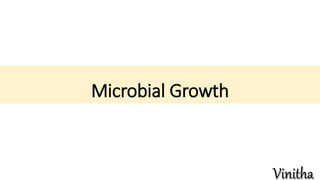
Microbial growth
- 2. What are microbes?? • A microorganism, or microbe, is a microscopic organism, which may exist in its single-celled form or in a colony of cells. • There are 5 basic groups of microorganisms: a. Bacteria b. Fungi c. Viruses d. Protozoa e. Algae
- 3. • Each type has a characteristic cellular composition, morphology, mean of locomotion, and reproduction. • Microbes are tiny living things that are found all around us and are too small to be seen by the naked eye. • They live in water, soil, and in the air. • The human body is home to millions of these microbes, some of which makes us sick, whereas some others are helpful too.
- 4. Growth?? • Growth in plants and animals is generally an increase in size. • But, in microorganisms, particularly bacteria, growth, refers to change in total population, rather than individual cells. • This chiefly includes binary fission. • A cell undergoing binary fission is immortal unless, it is deprived of nutrients or subjected to various stress. • Microbial growth occurs in a geometric progression.
- 6. Requirements for microbial growth 2. Chemical • Carbon • Nitrogen, Sulphur and Phosphorous • Trace elements • Oxygen • Organic growth factors 1. Physical • Temperature • pH • Osmotic Pressure
- 7. Physical Factors 1. Physical • Temperature • pH • Osmotic Pressure
- 8. 1. Temperature • Optimum temperature required • Higher temperature: microbial membrane is disrupted • Lower temperature: membrane solidifies • 3 types; 1. Psychrophile: -20 to +10 °C eg; Oscillatoria, Chlamydomonas 2. Mesophile: 20 to 45 °C eg; E. coli, Streptococcus pneumoniae 3. Thermophile: 50 to 80 °C eg; Thermus aquaticus, Geogemma barosii
- 9. 2. pH • Drastic variation in pH can disrupt the plasma membrane or inhibit the activity of enzymes and transport proteins • 3 types; 1. Acidophiles: 0 to 5.5 eg; Thiobacillus, Ferroplasma 2. Neutrophiles: 5.5 to 8 eg; E. coli, Lactobacillus 3. Alkalophiles: 7.5 to 14 eg; Thermococcus alcaliphilus
- 10. 3. Osmotic Pressure • It is the minimum pressure which needs to be applied to a solution to prevent the inward flow of its pure solvent across a semipermeable membrane. • Bacteria classified into 2 based on osmotic pressure; 1. Osmophiles: Grow at high sugar concentration eg; Saccharomyces 2. Halophiles: Grow at high salt concentration eg; Halobacterium
- 11. Chemical Factors 2. Chemical • Carbon • Nitrogen, Sulphur and Phosphorous • Trace elements • Oxygen • Organic growth factors
- 12. • Bacteria are normally grown in culture media, where nutrients are supplied in the form of a solution. • The essential elements required for growth are usually supplied in the form of water, macro/micro molecules, inorganic ions etc. 1. Carbon 2. Nitrogen, Sulphur and Phosphorous 3. Trace elements 4. Oxygen 5. Organic growth factors
- 13. 1. Carbon • Classified as 1. Autotrophs: eg; Cyanobacteria 2. Heterotrophs: eg; Salmonella 2. Nitrogen, Sulphur and Phosphorous • Required for synthesis of cellular material • Nitrogen + Sulphur Protein Synthesis
- 14. • Nitrogen + Phosphorus Synthesis of DNA, RNA • Nitrogen: 14% dry weight • Sulphur and Phosphorous: 4% dry weight 3. Trace Elements • Fe, Cu, Mo and Zn • Required for the functioning of enzymes
- 15. 4. Oxygen • Classified into 4 types; 1. Obligate aerobes: grows only in the presence of oxygen 2. Obligate anaerobes: grows only in the absence of oxygen 3. Facultative anaerobes: require oxygen but can survive in absence of oxygen 4. Microaerophile: growth occurs only when oxygen is diffused into the medium 5. Aerotolerant anaerobes: exclusively anaerobic (fermentative) type of metabolism but they are insensitive to the presence of O2 High Low Level of O2
- 16. 5. Organic Growth Factors • Mainly of 3 types; 1. Purines and Pyrimidines: needed for synthesis of DNA and RNA 2. Amino acids: required for protein synthesis 3. Vitamins: needed as co-enzymes and functional group of certain enzymes
- 17. Bacterial Growth Curve • Consists of 4 phases; 1. Lag phase 2. Log/Exponential Phase 3. Stationary Phase 4. Death Phase
- 18. Summary • Microbes • Growth • Geometric Growth • Requirements needed for microbial growth • Bacterial Growth Curve
- 19. Thank You